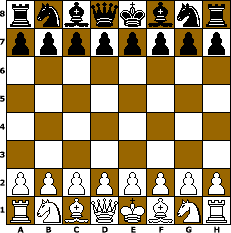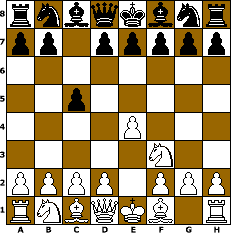Forsyth-Edwards Notation (FEN) is a standard notation for describing a particular board position of a Chess game. The purpose of FEN notation is to provide all the necessary information to restart a game from a particular position.
FEN is based on a system developed by the Scottish newspaper journalist, David Forsyth. Forsyth´s system became popular in the 19th century; Steven Edwards extended it to support use by computers. FEN is an integral part of the Portable Game Notation for chess games, since FEN is used to define initial positions other than the standard one. Notations such as FEN are critical for recording games in chess variants such as Fischer Random Chess where the initial position is not necessarily the traditional initial position.
Definition
A FEN "record" defines a particular game position, all in one text line and using only the ASCII character set. A text file with only FEN data records should have the file extension ".fen".
A FEN record contains 6 fields. The separator between fields is a space. The fields are:
- Piece placement (from white"s perspective). Each rank is described, starting with rank 8 and ending with rank 1; within each rank, the contents of each square are described from file a through file h. White pieces are designated using upper-case letters ("KQRBNP"), Black by lowercase ("kqrbnp"). Blank squares are noted using digits 1 through 8 (the number of blank squares), and "/" separate ranks.
- Active color. "w" means white moves next, "b" means black.
- Castling availability. If neither side can castle, this is "-". Otherwise, this has one or more letters: "K" (White can castle kingside), "Q" (White can castle queenside), "k" (Black can castle kingside), and/or "q" (Black can castle queenside).
- En passant target square. If there"s no en passant target square, this is "-". If a pawn has just made a 2-square move, this is the position "behind" the pawn.
- Halfmove clock: This is the number of halfmoves since the last pawn advance or capture. This is used to determine if a draw can be claimed under the fifty move rule.
- Fullmove number: The number of the full move. It starts at 1, and is incremented after Black"s move.
Examples
Here´s the FEN for the starting position:
rnbqkbnr/pppppppp/8/8/8/8/PPPPPPPP/RNBQKBNR w KQkq - 0 1

Here is the FEN after the common move 1. e4:
rnbqkbnr/pppppppp/8/8/4P3/8/PPPP1PPP/RNBQKBNR b KQkq e3 0 1

And then after 1. ... c5:
rnbqkbnr/pp1ppppp/8/2p5/4P3/8/PPPP1PPP/RNBQKBNR w KQkq c6 0 2

And then after 2. Nf3:
rnbqkbnr/pp1ppppp/8/2p5/4P3/5N2/PPPP1PPP/RNBQKB1R b KQkq - 1 2

|
